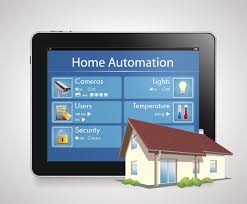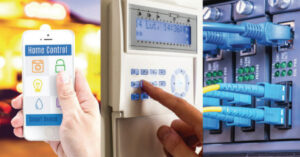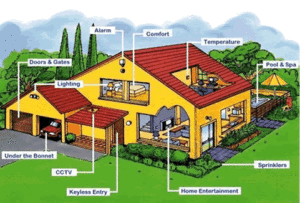Control and Automation Systems
What is Home Control & Automation?
Home automation connects all aspects of a system together through one central control panel, keypad or remote. Users can activate or deactivate an alarm system via the same control that activates a home theater, and temperature control. Used in what is called a “smart home” where virtually all home functions can be linked together and controlled via one central remote or keypad.
For some it may be something as simple as remote or automatic control of a few lights. For others, security may be the central application. Still others may choose to install advanced controllers or use voice recognition. As a very basic definition, we tend to refer to home automation as anything that gives you remote or automatic control of things around the home.
- Lighting and Appliance Control – Lights can be turned on or off from multiple locations or programmed to turn on or off along with other events.
- Security Systems & Access Control– Your alarm system can be used as a part of the control system. Lights can be turned on and off automatically as you turn you alarm on and off. Your system can call you and/or loved ones if there is an alert status. Additionally, you can unlock the front door to let friends in or close the garage door from your office via the web.
- Entertainment Systems – You can replacing that pile of remotes with just one controller. An you can press one button to dim your lights, close the drapes, turn on the TV, start the DVD Player and setup your audio system for your favorite movie. Speakers can be built-in throughout the home to provide quality sound wherever you desire.
- Communication Systems – Telephone, intercom and internet. Phone systems which are usually used for small business applications are surprisingly convenient in the home. With caller ID and a home automation controller you can even screen your calls for only those you wish to cause your phone to ring. Voice control software can turn every phone in your home into a way to control your system.
- Thermostats – Remote control thermostats allow you to adjust the temperature from bed at night or even from a cell phone while on your way home (or to your 2nd home!). They can even trigger a notice to you if the temperature gets too low (freezing pipes) or too high (pets, plants, etc.).
- Irrigation – Have your sprinklers turn on only when it’s dry. Some of our customers even turn the sprinklers on when there’s motion in the yard at unwanted times – imagine someone trying to explain the wet clothes to the police!
- Data Systems – Multiple PC’s and other data devices can be interconnected to each other and to your automation system.
- and Almost Anything Else You Can think of-
What’s great is that many of today’s home automation products need no new wires – so they are perfect to retrofit into an existing home. If you are building new, or doing a major remodel, please consider adding networking, audio, video and control wiring while it is easy and relatively inexpensive, later on you’ll be happy you did. Adding home automation to an existing home is surprisingly affordable and simple.
What are the Benefits of Home Automation?
Home automation can maximize your quality of life, allow you to experience the best that technology has to offer and to allow you to enjoy some much needed energy savings.
Home automation makes life more convenient, safe and fun!
- Convenience – Home automation is about the convenience of saving time and effort by having the home automatically do routine functions for you.
- Adjust the temperature from your bed
- Control the volume of your audio system from any room
- Warm your bathroom automatically 5 minutes before your alarm clock goes off so that it is warm when you enter.
- Fully enjoy home theater time by having the lights dim, curtains close, TV and DVD player turn on, phone mute and popcorn popper start… all with the touch of just one button.
- Energy Savings – Home automation is about the energy savings you will enjoy by regulating the operation of lights, water heater, HVAC system, entertainment components, appliances and irrigation system so these devices are on only when needed.
- Safety – Home automation is about the security you have knowing that you can look in on your home remotely from anywhere in the world, or that your home will phone or e-mail you if anything is amiss, or that your water supply will automatically shut off in the event a leak threatens to flood your home. It is the security of knowing that a fire will alert your system to wake you, shut down the gas and ventilation system, turn on a lighted path for your escape, and automatically phone the fire department. Home automation means the feeling of safety you get by turning on lights with your key fob to come home to a well lit home or knowing that your whole house will light up when there is motion detected at any corner of your house.
- Fun – High tech products for the home are fun to use and show to others. Whether viewing visitors at your front door on your TV or tuning your favorite radio or TV station with a voice command, you’ll find it surprisingly enjoyable. And, when it comes to impressing the friends, you’ll be happy to show off your sophisticated system
How Are All These Devices Connected?
The concept of Home Automation and Networking is to connect all of these systems and devices together on a network so that they can be controlled with a common interface and react to each other. For example if you start a movie on the VCR, the lights dim and the telephone directs calls to the answering machine.
In order for these devices to communicate with each other there must be a connection either via a wire of some sort or a radio signal (wireless). Because each system has different requirements as to speed of communication and volume of information to be communicated … different media (wire etc.) is necessary depending on the application. Currently these media are:
- Powerline – The home’s traditional electrical system already connects lights and appliances together and has outlets throughout the home. It’s limitations as a network medium relate to the capacity of the wire (low speed and low volume). Currently it is used for Lighting and appliance networks as well as some security applications. New developments in technology are introducing communication and data to the powerline network.
- Phone Lines – Most homes have several telephone outlets already in place. This wire is suitable for voice communications, data and even entertainment networking with new technologies and applications developing swiftly.
- Radio Signals (Wireless) – New standards and technologies are evolving wireless solutions from the traditional lighting, appliance and security networks to communication, data and some entertainment systems.
- Structured Wiring – New or renovated homes should install modern wiring systems to provide the capacity for current and future networks. A typical wiring system will include RG-6 (coaxial) wire for multi room entertainment systems, CAT 5 wire for data and communications as well as special wiring for speakers, home controls etc. Fiber optic cable is also being installed in some homes for future capacity.
How Do I Control the System?
 A combination of devices can be used to communicate with and control the network. Touch pads and/or remotecontrol devices, your tablet or smartphone (for both manual and voice control) and or PC keyboard and mouse are all ways that you can control your home automation system.
A combination of devices can be used to communicate with and control the network. Touch pads and/or remotecontrol devices, your tablet or smartphone (for both manual and voice control) and or PC keyboard and mouse are all ways that you can control your home automation system.

